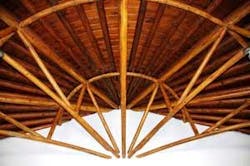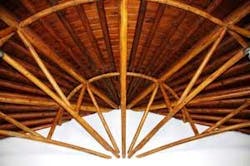Recycling and ingenuity are not new concepts in the oil and gas industry. A ranch in the Texas Hill Country is known for the unique oil field-pipe construction of buildings from the 1930s and 1940s, engendered by thriftiness during the Great Depression.
Daniel James Moran became president of Marland Oil Co. in 1928 and oversaw the merger with Continental Oil & Transportation Co. in 1929.
Moran “shepherded the company [Continental Oil Co.] through the worst days of the depression…reduced the company’s debt, and reintroduced habits of frugality and careful management.”1
In June 1936, Moran bought nearly 7,000 acres along the north fork of the Guadalupe River in Kerr County, Tex., which he named “Mo-Ranch.”
He called up a Conoco construction crew and used old pipe, sucker rods, and steel from scrapped derricks and local limestone as building materials to develop this family ranch and company retreat. Some of the pipe is easy to spot in bridges and roof supports, but most provides hidden structural support in buildings or, buried throughout the property, carries electrical and water lines.
“Every day you dig in the ground, you find something new or different,” said Mark Perhamus, director of facilities at Mo-Ranch. “Oil field pipe was used for everything.”
Bridges
A 462-ft long “catwalk” (cover) spans Wilson Draw, named for W.W. Wilson, who owned the ranch 1924-28.
Moran designed and built the bridge using 4-in. junked pipe for the main structure and top rail and sucker rods for the parallel horizontals lining each side of the walkway, Perhamus says.
Moran brought a hydraulic pipe bender to the ranch to create the arching bridge supports. The catwalk is supported in midspan by the bottom part of a derrick and the “halfway house” is an old rig house from the 1930s. The light posts along the bridge once held red letters that spelled out “CONOCO.”2
The nearby “kittywalk” bridge is 83 ft long and was built in a similar manner.
Buildings
Perhamus says the Moran-era buildings used 4-in. and 2-in. OD pipe for framing and roof support. “Then they were rocked, so [that] much of the structural pipe is hidden.” The solid walls are as thick as 2 ft and the original windows were set in steel casement frames welded to pipe inside the walls.
In addition to the larger tubulars, Perhamus says sucker rods were used extensively. “All of the buildings used this rod for concrete reinforcement and for angle braces.”
Moran built the first four rock buildings in 1936, a swimming pool complex in 1937, a guest lodge in 1938, and a gymnasium and skating rink in 1939, with pipe support beams painted to resemble wood. In 1941, he added the stone chapel, with oil pipe used in the ceiling vaulting, and then in 1943, the “Scout” building. Beyond the cavernous, whitewashed lobby with its large hearth and Mexican tile, large dormitory rooms are crowned with ceilings of wood and decorative, faux-finished oil pipes (see photo).
Legacy
When Dan Moran died Apr. 3, 1948, his family put the property on the market.
In June 1949, the Presbyterian Synod of Texas purchased it for $512,500. It sold 6,500 acres of unimproved ranchland to the Texas Game and Fish Commission; that land eventually became the Kerr Wildlife Management Area.
Mo-Ranch now operates as a conference facility on about 500 acres, 10 river crossings west of Hunt, Tex. (www.moranch.com).
References
- Blauvelt, H., Conoco, The First One Hundred Years, 1975.
- Lively, R.D., By Streams of Water, 1987.


